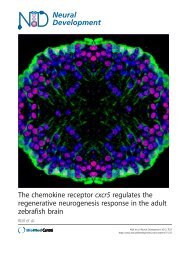Neural Development - BioMed Central
Neural Development - BioMed Central
Neural Development - BioMed Central
You also want an ePaper? Increase the reach of your titles
YUMPU automatically turns print PDFs into web optimized ePapers that Google loves.
<strong>Neural</strong> <strong>Development</strong> 2009, 4:1<br />
http://www.neuraldevelopment.com/content/4/1/1<br />
was identified from several positive clones after confirmation<br />
steps. NM23-X1, -X2, and -X3 expression plasmids<br />
were kindly provided by Dr A Mazabraud [27]. Through a<br />
Xenopus EST database search and blast search we identified<br />
NM23-X4 [GenBank:BU900096], -X5 [Gen-<br />
Bank:CK805921], -X6 [GenBank:BX845338], -X7 [Gen-<br />
Bank:BG555939] and -X8 [GenBank:BE679366]. All<br />
clones were obtained and subcloned in a pCS2FLAG vector.<br />
Mutants H148C, S150G, KPN loop, and (1-33) of<br />
NM23X4 were made with a site-directed mutagenesis or<br />
deletion strategy in pCS2FLAG according to standard procedures.<br />
The p27Xic1, its mutants and the p16Xic2 constructs<br />
were described previously [13,30]. HA-tagged<br />
constructs were made using HA-pcDNA3 vector.<br />
Design of shRNA constructs for p27Xic1 and NM23-X4<br />
shRNA target sequences were designed using the web site<br />
siDirect [47]. Two shRNA constructs against different target<br />
sites were constructed using pSUPER (Oligoengine<br />
Seattle, Washington, USA)). The designed oligonucleotides<br />
for p27Xic1 and NM23-X4 are as follows: shXic1-A<br />
forward,<br />
gatccccgcggtgccagggagttaaattcaagagatttaactccctggcaccgctttt<br />
tggaaa; shXic1-A reverse, agcttttccaaaaagcggtgccagggagttaa<br />
atctcttgaatttaactccctggcaccgcggg; shXic1-B forward, gatcccc<br />
ccgtggagactaaagatgtttcaagagaacatctttagtctcccacggtttttggaaa;<br />
shXic1-B reverse, agcttttccaaaaaccgtggagactaaagatgttctcttga<br />
aacatctttagtctccacggggg; shX4-A forward, gatcccccgactggtgg<br />
gagaaatcattcaagagatgatttctcccacagtcgtttttggaaa; shX4-A<br />
reverse, agcttttccaaaaacgactggtgggagaaatcatctcttgaatgatttctc<br />
ccaccagtcggggg; shX4-B forward, gatccccgcagcgtggcttcacatta<br />
ttcaagagataatgtgaagccacgctgctttttggaaa; shX4-B reverse,<br />
agcttttccaaaaagcagcgtggcttcacttatctcttgaataatgtgaagccacgctgcggg.<br />
The oligonucleotides were annealed and then<br />
ligated in pSUPER.<br />
Xenopus embryo manipulation, mRNA injection, and<br />
lipofection<br />
Xenopus laevis embryos were obtained by in vitro fertilization,<br />
and staged according to Niewkoop and Faber. All<br />
embryo manipulations were in accordance with the UK<br />
Home Office regulations and guidelines. For mRNA injection,<br />
all plasmids (pCS2FLAG-NM23X1, X4, pCS2-<br />
p27Xic1, pCS2-ngal) were linearized and transcribed in<br />
vitro using the mMessage mMachine kit (Ambion Austin,<br />
TX, USA)). The mRNAs were injected into one blastomere<br />
at the two-cell stage. Lipofection into eye primordia was<br />
performed as described [48]. The indicated constructs<br />
were lipofected in the eye field of embryos at stage 15. At<br />
stage 41, the lipofected embryos were fixed and cryostat<br />
sectioned as previously described. For cell-tracing purposes,<br />
pGFP plasmid was co-lipofected with all plasmids.<br />
In some cases, co-lipofection was confirmed by immunohistochemistry<br />
against the myc or FLAG tag. Cell types<br />
were determined by morphology and location of cell<br />
body and nucleus along the retinal epithelium and confirmed<br />
by cell type specific antibody staining. About 400<br />
cells from 6 retinas were counted in each condition. Each<br />
experiment was repeated at least three times. Statistical<br />
analysis was performed by one-way ANOVA.<br />
Proliferation assays<br />
BrdU experiments in Xenopus retina were performed as<br />
described in our previous paper [13]. Briefly, the indicated<br />
construct was co-lipofected with a GFP plasmid at stage<br />
15. BrdU was injected in the abdomen from stage 30 to<br />
stage 41 at intervals of 8 h. The embryos were then fixed<br />
in 4% paraformaldehyde and sectioned. The section was<br />
treated with 2 N HCl and subjected to BrdU antibody<br />
staining according to the manufacturer's protocol (Roche<br />
Lewes. East Sussex, UK)). We then determined the ratios<br />
of BrdU and GFP double positive cells of the inner nuclear<br />
layer (Müller glial cells, bipolar, amacrine and horizontal<br />
cells) and ganglion cell layer. For the proliferation assay in<br />
early embryos, mRNA was injected into a right blastomere<br />
at the two-cell stage and the injected embryos were fixed<br />
at stage 7. The cell diameter of approximately 20 cells<br />
(longest length) was measured after taking images using<br />
the Openlab software (Improvision, Coventry, West Midland,<br />
UK). Then, the ratio between the diameter of<br />
injected and uninjected sides was calculated (Figure 8C).<br />
RNA extraction and RT-PCR<br />
RNA extraction and RT-PCR were carried out as described<br />
[49]. The primers used were: NM23-X1 (forward, 5'-GAG-<br />
GGACTGAATGTGGTAAA-3'; reverse, 5'-TTTAAAC-<br />
CACAAGGCAATTT-3'); NM23-X4 (forward, 5'-<br />
AGCAGAACATTACCATGACC-3'; reverse, 5'-TAGCCT-<br />
GGGAAGAGTCTGTA-3'). The primers for ornithine<br />
decarboxylase have been described previously [30].<br />
In situ hybridization and immunohistochemistry<br />
In situ hybridization of whole embryos and sections was<br />
carried out as described previously [13]. Probes were prepared<br />
after linearization of pBluescript plasmids encoding<br />
the full-length cDNA of NM23 members or p27Xic1 and<br />
digoxigenin- or FITC-labelling in vitro with polymerase T7<br />
or T3. In situ hybridization on cryostat sections was performed<br />
after untreated embryos were fixed, sucrose<br />
treated and embedded in OCT compound. Colour reactions<br />
were performed using BM Purple and Fast Red<br />
(Roche) according to standard procedures. Immunohistochemistry<br />
was preformed as described [8]. Primary antibodies<br />
used were anti-R5 (1:1), anti-CRALBP (1:1000;<br />
from J Saari), anti-calbindin (1:100; Sigma St. Louis, MO,<br />
USA), anti-39.4 D5 (1:100), and anti-FLAG (1:100;<br />
Sigma). All immunostainings were visualized with fluorescent<br />
conjugated secondary antibodies under a fluorescent<br />
microscope.<br />
Page 16 of 18<br />
(page number not for citation purposes)




